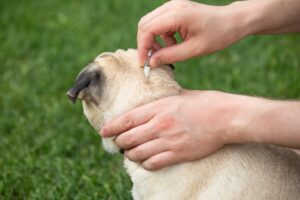Ten Steps to Your Pet’s Dental HealthCourtesy of the ASPCA
DOGS
Did you know that regularly brushing your dog’s teeth and providing her with a healthy diet and plenty of chew toys can go a long way toward keeping her mouth healthy? Many pooches show signs of gum disease by the time they’re four years old because they aren’t provided with proper mouth care—and bad breath is often the first sign of a problem. Give your dog regular home checks and follow the tips below, and you’ll have a very contented pooch with a dazzling smile.
- The Breath Test: Sniff your dog’s breath. Not a field of lilies? That’s okay—normal doggie-breath isn’t particularly fresh-smelling. However, if his breath is especially offensive and is accompanied by a loss of appetite, vomiting or excessive drinking or urinating, it’s a good idea to take your pooch to the vet.
- Lip Service: Once a week, with your dog facing you, lift his lips and examine his gums and teeth. The gums should be pink, not white or red, and should show no signs of swelling. His teeth should be clean, without any brownish tartar.
- Signs of Oral Disease: The following are signs that your dog may have a problem in his mouth or gastrointestinal system and should be checked by a veterinarian:
-
- Bad breath
- Excessive drooling
- Inflamed gums
- Tumors in the gums
- Cysts under the tongue
- Loose teeth
-
- The Lowdown on Tooth Decay: Bacteria and plaque-forming foods can cause build-up on a dog’s teeth. This can harden into tartar, possibly causing gingivitis, receding gums and tooth loss. One solution? Regular teeth cleanings, of course.
- Canine Tooth-Brushing Kit: Get yourself a toothbrush made especially for canines or a clean piece of soft gauze to wrap around your finger. Ask your vet for a toothpaste made especially for canines or make a paste out of baking soda and water. Never use fluoride with dogs under six months of age—it can interfere with their enamel formation. And please do not use human toothpaste, which can irritate a dog’s stomach. Special mouthwash for dogs is also available—ask your vet.
- Brightening the Pearly Whites: Taking these steps will make brushing a lot easier for the both of you:
-
- First get your dog used to the idea of having her teeth brushed. Massage her lips with your finger in a circular motion for 30 to 60 seconds once or twice a day for a few weeks. Then move on to her teeth and gums.
- When your pooch seems comfortable being touched this way, put a little bit of dog-formulated toothpaste or a paste of baking soda and water on her lips to get her used to the taste.
- Next, introduce a toothbrush designed especially for dogs—it should be smaller than a human toothbrush and have softer bristles. Toothbrushes that you can wear over your finger (or a clean piece of gauze) are also available and allow you to give a nice massage to your dog’s gums.
- Finally, apply the toothpaste to her teeth for a gentle brushing
- A veterinary exam beforehand may be helpful to find out if your dog’s gums are inflamed. If your dog has mild gingivitis, brushing too hard can hurt her gums.
-
- Brushing Technique: Yes, there is actually a technique! Place the brush or your gauze-wrapped finger at a 45-degree angle to the teeth and clean in small, circular motions. Work on one area of your dog’s mouth at a time, lifting her lip as necessary. The side of the tooth that touches the cheek usually has the most tartar, and giving a final downward stroke can help to remove it. If your dog resists having the inner surfaces of her teeth cleaned, don’t fight it—only a small amount of tartar accumulates there. Once you get the technique down, go for a brushing two or three times a week.
- Know Your Mouth Disorders: Getting familiar with the possible mouth problems your dog may encounter will help you determine when it’s time to see a vet about treatment:
-
- Periodontal disease is a painful infection between the tooth and the gum that can result in tooth loss and spread infection to the rest of the body. Signs are loose teeth, bad breath, tooth pain, sneezing and nasal discharge.
- Gingivitis is an inflammation of the gums caused mainly by accumulation of plaque, tartar and disease-producing bacteria above and below the gum line. Signs include bleeding, red, swollen gums and bad breath. It is reversible with regular teeth cleanings.
- Halitosis—or bad breath—can be the first sign of a mouth problem and is caused by bacteria growing from food particles caught between the teeth or by gum infection. Regular tooth-brushings are a great solution.
- Swollen gums develop when tartar builds up and food gets stuck between the teeth. Regularly brushing your dog’s teeth at home and getting annual cleanings at the vet can prevent tartar and gingivitis.
- Proliferating gum disease occurs when the gum grows over the teeth and must be treated to avoid gum infection. An inherited condition common to boxers and bull terriers, it can be treated with antibiotics.
- Mouth tumors appear as lumps in the gums. Some are malignant and must be surgically removed.
- Salivary cysts look like large, fluid-filled blisters under the tongue, but can also develop near the corners of the jaw. They require drainage, and the damaged saliva gland must be removed.
- Canine distemper teeth can occur if a dog had distemper as a puppy. Adult teeth can appear looking eroded and can often decay. As damage is permanent, decayed teeth should be removed by a vet.
-
- Chew on This: Chew toys can satisfy your dog’s natural desire to chomp, while making his teeth strong. Gnawing on a chew toy can also help massage his gums and help keep his teeth clean by scraping away soft tartar. Ask your vet to recommend toxin-free rawhide, nylon and rubber chew toys.P.S.: Gnawing also reduces your dog’s overall stress level, prevents boredom and gives him an appropriate outlet for his natural need to chew.
- Diet for Healthy Teeth: Ask your vet about a specially formulated dry food that can slow down the formation of plaque and tartar. Also, avoid feeding your dog table scraps, instead giving him treats that are specially formulated to keep canine teeth healthy.
CATS
Even if the only things your cat hunts these days are chicken-flavored kibbles and toy mice, he still needs clean, sharp teeth and healthy gums. Damage to the tongue, teeth, palate and gums can lead to many health risks for felines, but these can be prevented with regular home check-ups and good old-fashioned tooth brushings.
- The Breath Test Go on, take a sniff. It doesn’t have to be a long one—cat breath may not smell like roses, but it shouldn’t be offensive either. If your kitty’s mouth has an abnormally strong odor, he may have digestive problems or a gum condition such as gingivitis, and should be examined by a vet.
- Lip Service: With your cat facing you, gently push back his lips and take a look. The gums should be firm and pink, not white or red, and should show no signs of swelling. The teeth should be clean and free of any brownish tartar, and none should be loose or broken.
- A Closer Look: Watch for any of the following signs that could indicate problems in your cat’s mouth:
-
- Dark red line along the gums
- Red and swollen gums
- Ulcers on gums or tongue
- Loose teeth
- Pus
- Difficulty chewing food
- Excessive drooling
- Excessive pawing at the mouth area.
-
- Dangerous Swelling: At any sign of gum inflammation, you should take your cat in for a veterinary exam. If left untreated, gum disease can develop, possibly leading to tooth loss or inability to eat. Inflammation may also point to an internal problem like kidney disease or Feline Immunodeficiency Virus.
- The Lowdown on Tooth Decay: Bacteria and plaque-forming foods can cause a buildup on a cat’s teeth. This can harden into tartar, possibly causing gingivitis, receding gums and tooth loss. The solution? Regular teeth cleanings, of course.
- Your Cat’s Tooth-Brushing Kit: All you’ll need to brush your cat’s teeth are cotton swabs and a small toothbrush and tube of toothpaste formulated for felines. You can also use salt and water. Ask your vet to suggest the brushing supplies that he trusts, and be sure never to use toothpaste designed for people—the ingredients can be unhealthy for your cat.
- Brightening the Pearly Whites: Brush your cat’s teeth at home by following these simple steps:
-
- First get your cat used to the idea of having her teeth brushed. Start by gently massaging her gums with your fingers or touching a cotton swab to them.
- After a few sessions, put a little bit of cat-formulated toothpaste on her lips to get her used to the taste.
- Next, introduce a toothbrush designed especially for cats—it will be smaller than human toothbrushes and have softer bristles. Toothbrushes that you can wear over your finger are also available and allow you to give a nice massage to your cat’s gums.
- Finally, apply the toothpaste to her teeth for a gentle brushing.
- A veterinary exam beforehand may be helpful to find out if your cat’s gums are inflamed. Many cats have mild gingivitis and brushing too hard can hurt their gums.
-
- Chew on This: Chew toys can satisfy your cat’s natural desire to chomp, while making her teeth strong. Gnawing on a chew toy can also help floss your cat’s teeth, massage her gums and scrape away soft tartar.
- Diet for Healthy Teeth: If your cat has dental troubles, ask your veterinarian to recommend a kibble that keeps feline teeth healthy and helps to remove plaque buildup.
- Know Your Mouth Disorders: If your cat suffers from any of the symptoms mentioned below, please see the vet right away:
-
- Gingivitis: This inflammation of the gums is mainly seen in older cats. It may start as a dark red line bordering on the teeth. If left untreated, gums may become sore and ulceration may occur. May be a sign of FIV or other infection.
- Periodontitis: If gingivitis invades the tooth socket, the tooth may become loose and an abscess may form.
- Stomatitis: This inflammation of the mouth lining may result from a foreign body in the mouth, a viral disease or dental problems. The cat will have difficulty eating and the inside of the mouth will appear red.
- Rodent Ulcer: A slowly enlarging sore or swelling on the upper lip.
- Salivary Cyst: If salivary glands or ducts that carry saliva to the mouth become blocked, a cyst may form under the tongue.
- Mouth Ulcers: Ulcers on a cat’s tongue and gums are sometimes caused by feline respiratory or kidney disease.
-




